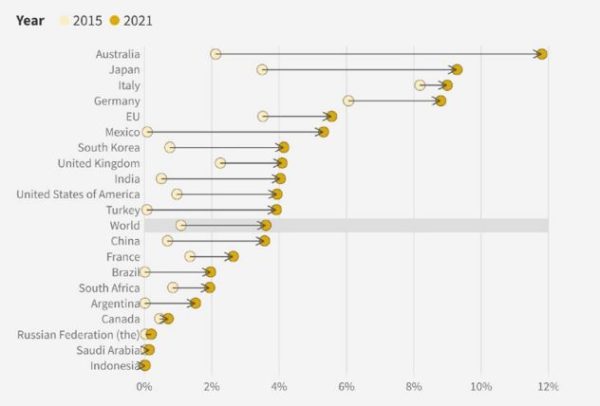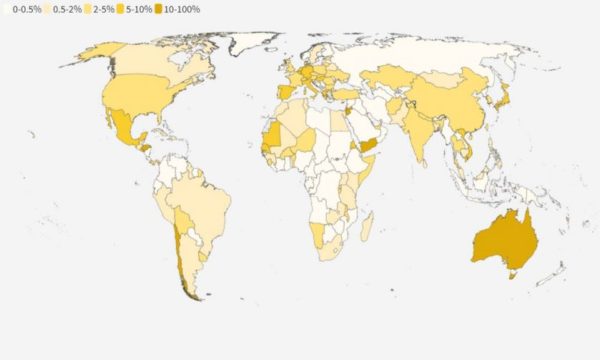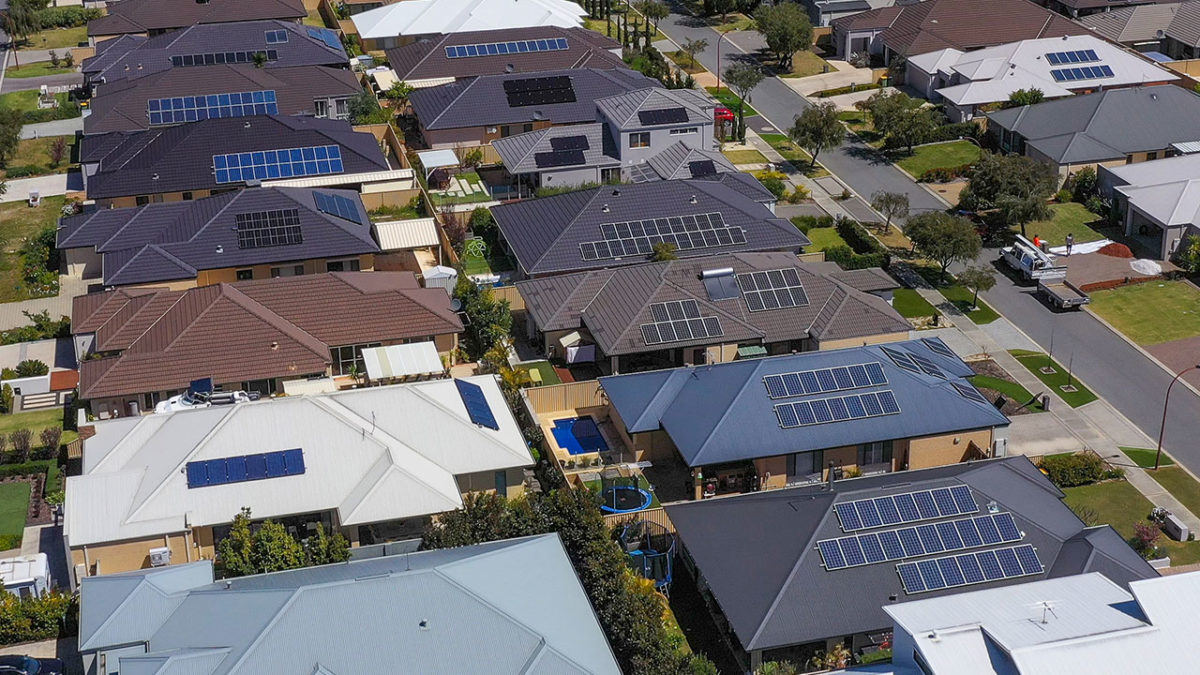Independent climate and energy think tank Ember’s third annual Global Electricity Review shows that global solar generation rose 23% in 2021, increasing year-on-year by 188TWh to 1,023TWh. It was the fastest rising source of electricity generation for the 17th consecutive year.
Ember said solar generated 3.7% of the world’s electricity in 2021 and Australia is at the vanguard, sourcing 12% of its electricity from the renewable technology, the highest proportion of any major country in the world.
While solar generation rose 23% globally in 2021, wind supply gained 14% over the same period, increasing 227TWh to 1,814TWh. Together, both renewable sources accounted for 10.3% of total global electricity generation, up 1% from 2020. Combined, wind and solar are now the fourth largest source of electricity in the world.

of G20 countries.
Image: Ember
David Jones, program lead at Ember, said the report demonstrated that wind and solar had arrived, with clean sources generating 38% of the world’s electricity in 2021.
“The process that will reshape the existing energy system has begun,” he said.
“Even as coal and power emissions hit another all-time high, there are clear signs that the global electricity transition is well underway. More wind and solar is being added to grids than ever. And not just in a few countries, but across the world.
“We’re getting closer to that break-even where wind and solar can cover new electricity demand, but we are still not quite there. If we maintain those growth rates we see, we will be there shortly.”
Ember’s report analysed annual power generation data for 209 countries from 2000 to 2020. For 2021, data was added from 75 countries, which together represented 93% of global demand.
The report shows that 50 countries generated more than 10% of their power from wind and solar, with Australia’s shift to wind and solar energy in the past two years greater than anywhere in the world except the Netherlands.
Ember said the share of solar and wind in Australia’s electricity market rose from 13% to 22% last year.

Image: Ember
Jones said Australia’s renewable energy transition had been driven by the widespread embrace of rooftop solar and had occurred despite the federal government’s continued support for fossil fuels.
“This is very different from many countries, where national governments lead the charge,” he said.
“It’s very refreshing to see so many people embracing homegrown solar, even as the national government continues to push for more oil and gas.”
Despite the record growth in wind and solar, the report also revealed that coal-fired power generation saw its fastest growth since at least 1985, rising 9% in 2021 to 10,042TWh. The record rise in coal was not matched by global gas generation, which increased by only 1% in 2021.
This came in a year of rapid demand recovery, as 2021 saw the largest recorded annual increase of 1,414TWh in global electricity demand, up 5.4% and the equivalent of adding a new India to global demand, the report said.
This content is protected by copyright and may not be reused. If you want to cooperate with us and would like to reuse some of our content, please contact: editors@pv-magazine.com.









3 comments
By submitting this form you agree to pv magazine using your data for the purposes of publishing your comment.
Your personal data will only be disclosed or otherwise transmitted to third parties for the purposes of spam filtering or if this is necessary for technical maintenance of the website. Any other transfer to third parties will not take place unless this is justified on the basis of applicable data protection regulations or if pv magazine is legally obliged to do so.
You may revoke this consent at any time with effect for the future, in which case your personal data will be deleted immediately. Otherwise, your data will be deleted if pv magazine has processed your request or the purpose of data storage is fulfilled.
Further information on data privacy can be found in our Data Protection Policy.